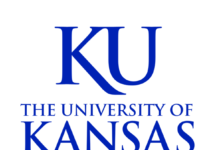The oldest consecutive event of its kind in Kansas, the Flint Hills Rodeo ticks on almost constantly, like a fully wound watch. It carries on, rain or shine, and it’s a study in holding to purpose amid change.
Drops of rain splatter on wooden bleachers and gravel roads, on horse trailers, horses and people.
The drops come gently at first, then more and more abundantly. Within a minute, a downpour is encompassing Strong City. Buildings within the small community along U.S. Highway 50 in Chase County are tinged a darker shade by brief heavy rains, the result of pop-up thunderstorms feeding off late spring humidity. Dogs bark as thunder rumbles through the verdant Flint Hills.
Moody shifts in weather can’t deter townsfolk and travelers alike from setting up camp along Cottonwood Avenue, Strong City’s main drag. On this day, they’re saddling up to celebrate a time-tested Kansas tradition that’s well-known among amateur and professional cowpokes alike.
Some years it rains all three days of the Flint Hills Rodeo, according to Mike Holder, who served on the rodeo board of directors for 27 years before becoming a lifetime board member.
“We’re in the middle of the Flint Hills,” Holder says as he sits on the dance floor at the rodeo grounds on the north side of town. His voice is graveled, his blue eyes kind. “This is cattle country.”
On the opening night of the Flint Hills Rodeo, Tex Junker, 86, of Roggen, Colorado, stood at attention as the national anthem was played. Junker started competing in the rodeo in 1956 and hasn’t missed one since. (Credit: Jeff Tuttle)
In the 1930s, Chase County rancher Emmett Roberts staged pasture rodeos on his farm west of Strong City. In 1937, he held his first organized rodeo event. The following year, Roberts teamed up with his son, Ken, and son-in-law Eddie Boysen, to host what they called the First Annual Chase County Rodeo. In 1939, the event was renamed the Flint Hills Rodeo.
It’s been going nearly continuously ever since. (The only year it was canceled was 2020, because of the pandemic.) Held the first weekend in June, the rodeo is still billed as “the oldest consecutive rodeo in Kansas.” The same arena and rodeo grounds that were built for the event back in 1948 remain in use today.
On the final day of the rodeo, the community celebrates with a parade leading south from town along Kansas 177 two miles to Cottonwood Falls. The liquor store, train depot and antique gas station downtown are popular spots for revelers to gather; a few rowdier participants prep water balloons for unsuspecting parade entrants.
Chase County Sheriff Jacob Welsh led this year’s parade, followed by emergency vehicles and work trucks, their passengers tossing candy as they drove by. Local Shriners performed tricks on Honda three-wheelers and squealed the tires on their tiny chopper bikes. Horses ridden by smiling and waving cowboys and cowgirls trotted down the street. More sweet treats were thrown from parade sponsor floats. Children watching roadside quickly snatched them up to add to their goody collections.
Then the onslaught began. The crowd, which banked water balloons in between games of cornhole, began using them, hurling aquatic grenades over people watching the parade. Some balloons landed with great effect, splashing against county firetrucks with a thump and a spray onto the pavement. At least one balloon careened into a car to douse its occupants.
Even chaotic merriment has rules. The rowdies knew better than to drench the driver of an immaculate 1967 Pontiac GTO. Other drivers, including some who weren’t trying to be part of the parade, didn’t get a pass.
From the skies, more water comes.
Rodeo organizer Cheryl Bailey laughed as she sought shelter from the rain for her and her ATV under the dance floor. Bailey’s grandfather helped build the bleachers that rodeogoers still sit on. Her family has been involved in the event for about 80 years.
“My dad was up here pulling ropes in the stripping chute,” Bailey says. “My mom was always helping. My grandpa always helped with stuff.”
Bailey has served on the Flint Hills Rodeo board for about 25 years.
“Her family’s been involved (in the rodeo) forever,” Holder says, “and that’s part of what helps keep an event like this going.”
Bailey, Holder and the roughly 200 other
volunteers who fan out across the rodeo grounds before, during and after the show work together every year to make sure the rodeo continues its legacy. There are no weather delays – except if there’s lightning in the area – and no rescheduling or postponing events. The rodeo carries on, rain or shine.
This year turned out to be a rainy one. Another deluge soaked the rodeo grounds as cowboys herded goats and calves into their pens ahead of the children’s competitions. The arena was mostly mud by the time the main event began. Some years, that’s just how it goes.
Holder admits that some years are better than others regarding ticket sales and attendance, but there’s a hearty core of people who attend, no matter the weather forecast. Rodeo competitors hold the event in high regard, seldom failing to mention how much fun it is to be part of a longstanding tradition.
Holder says there’s a thread of leadership embedded within the Flint Hills Rodeo, directly related to its homegrown origins.
“Leadership comes from ownership,” Holder says. “If you help build it, well, then you feel like you’re a part owner of it.”
As reported in the Kansas Leadership Center Magazine.




